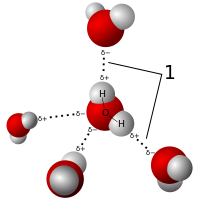
Photo from wikipedia
Supramolecular self-assembly of nanoparticles in two orthogonal directions would potentially allow one to fabricate nanomaterials with fascinating properties. In this study of a hydrothermal polycondensation of melamine/cyanuric acid, graphitic carbon… Click to show full abstract
Supramolecular self-assembly of nanoparticles in two orthogonal directions would potentially allow one to fabricate nanomaterials with fascinating properties. In this study of a hydrothermal polycondensation of melamine/cyanuric acid, graphitic carbon nitride-based quantum dots (CNQD, ∼2 nm) are in situ arranged along two orthogonal directions through lateral hydrogen bonding, and free-floating two-dimensional hydrogen-bonded films of CNQD (2D CNQD) are built. On the basis of the universality of this hydrothermal in situ supramolecular self-assembly technique, 2D films linked by other quantum dots such as sulfur-doped graphitic carbon nitride and CdTe are also constructed. With the benefits of stimuli responsiveness and the reversibility of hydrogen bonds, controllable assembly/disassembly of the 2D CNQD film is feasibly achieved by external stimuli such as inletting CO2/N2, which endows the assembled 2D CNQD films optimal electrochemical superiorities of both 2D film and zero-dimensional (0D) quantum dots. Accordingly, the 2D CNQD film delivers a high bifunctional activity in both a nitrogen reduction reaction (NRR) and an oxygen evolution reaction (OER). Especially in NRR, it exhibits the high yield rate of NH3 reaching 75.07 μg h-1 mg-1 at -0.85 V versus reversible hydrogen electrode at ambient condition. Strikingly, the power density of the rechargeable Zn-N2 battery using 2D CNQD film as cathode reaches 31.94 mW cm-2, outperforming the majority of Zn-N2 batteries. Density functional theory calculations proved the promoted adsorption of N2 and stabilized NRR intermediates on 2D CNQD cooperated by multiply hydrogen-bonding interactions are the main reasons for the excellent NRR electrocatalytic performances. This work hints that hydrothermal in situ supramolecular self-assembly is a feasible and direct way to integrate 0D quantum dots into 2D directional arrays, and the hydrogen bond that interlinks enables this free-floating 2D structure to maintain the electrochemical superiority of both 0D and 2D structures.
Journal Title: ACS nano
Year Published: 2022
Link to full text (if available)
Share on Social Media: Sign Up to like & get
recommendations!